Marketing Report: Strategies, Mix, and Customer Targeting Analysis
VerifiedAdded on 2020/06/06
|9
|2889
|43
Report
AI Summary
This report provides an introduction to marketing, exploring various techniques used by organizations. It defines marketing, outlines marketing objectives, and describes branding, the Ansoff Matrix, and relationship marketing. The report analyzes marketing strategies, including market development, branding, and brand positioning, with examples from Tesco and Marks & Spencer. It also discusses the limitations and constraints of marketing, referencing relevant legislation such as the Goods Act 1979 and the Consumer Protection from Unfair Trading Regulations 2008. Furthermore, the report examines how organizations use marketing research, including primary and secondary research methods, to contribute to development and marketing planning using SWOT analysis. It explains customer targeting strategies and develops a coherent marketing mix (product, price, place, and promotion) for a new product or service, providing a comprehensive overview of marketing principles and practices.
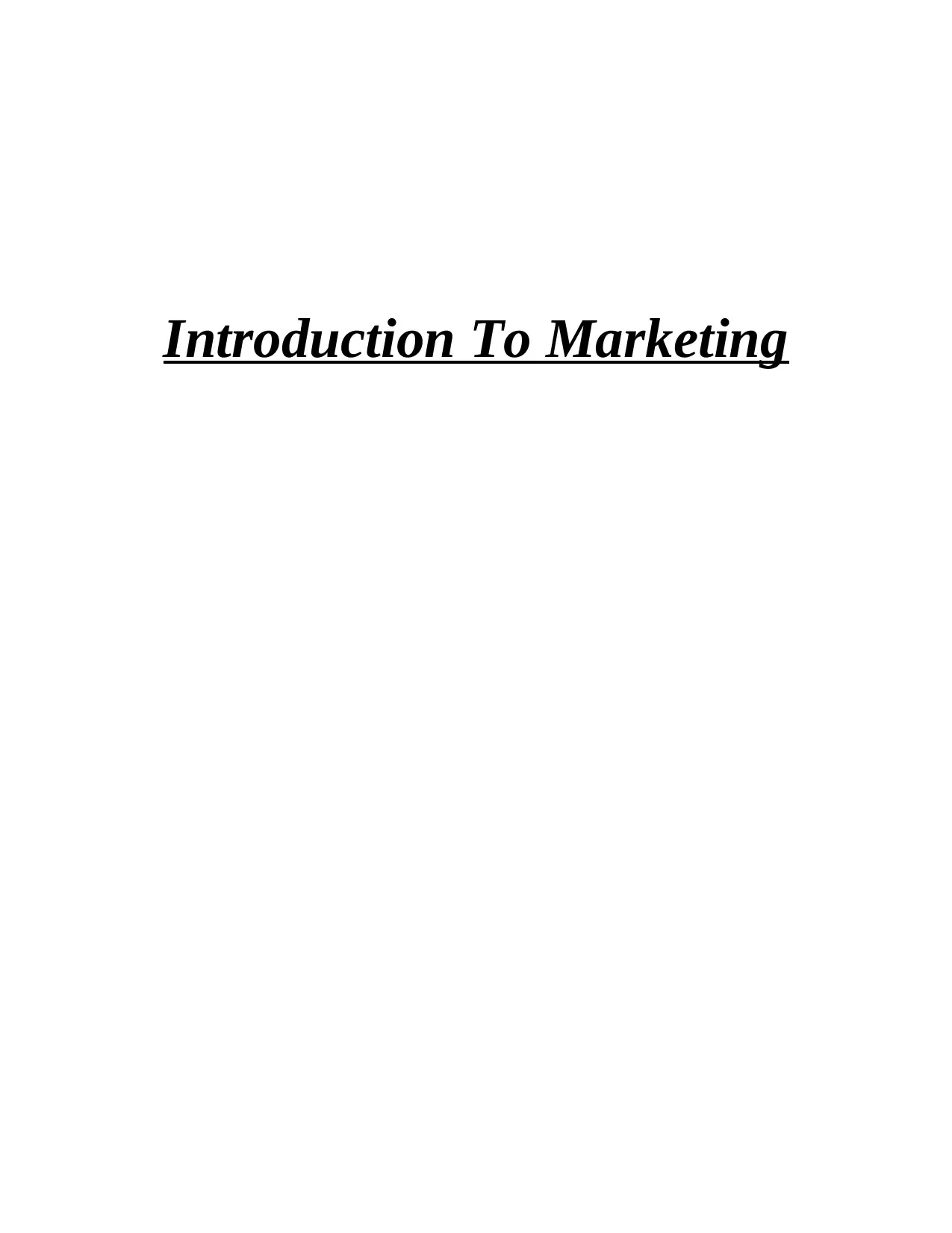
Introduction To Marketing
Paraphrase This Document
Need a fresh take? Get an instant paraphrase of this document with our AI Paraphraser

Table of Contents
INTRODUCTION...........................................................................................................................1
TASK 1............................................................................................................................................1
P1 Describe how marketing techniques are used to market products in two organisations.......1
P2. Description of limitations and constraints of marketing.......................................................2
TASK 2............................................................................................................................................3
P3. Organisation uses marketing research to contribute to development...................................3
P4 Use marketing research for marketing planning....................................................................4
TASK 3............................................................................................................................................5
P5 Explain how and why groups of customers are targeted for selected products.....................5
TASK 4............................................................................................................................................5
P6 Develop a coherent marketing mix for a new product or service..........................................5
CONCLUSION................................................................................................................................6
REFERENCES................................................................................................................................7
INTRODUCTION...........................................................................................................................1
TASK 1............................................................................................................................................1
P1 Describe how marketing techniques are used to market products in two organisations.......1
P2. Description of limitations and constraints of marketing.......................................................2
TASK 2............................................................................................................................................3
P3. Organisation uses marketing research to contribute to development...................................3
P4 Use marketing research for marketing planning....................................................................4
TASK 3............................................................................................................................................5
P5 Explain how and why groups of customers are targeted for selected products.....................5
TASK 4............................................................................................................................................5
P6 Develop a coherent marketing mix for a new product or service..........................................5
CONCLUSION................................................................................................................................6
REFERENCES................................................................................................................................7
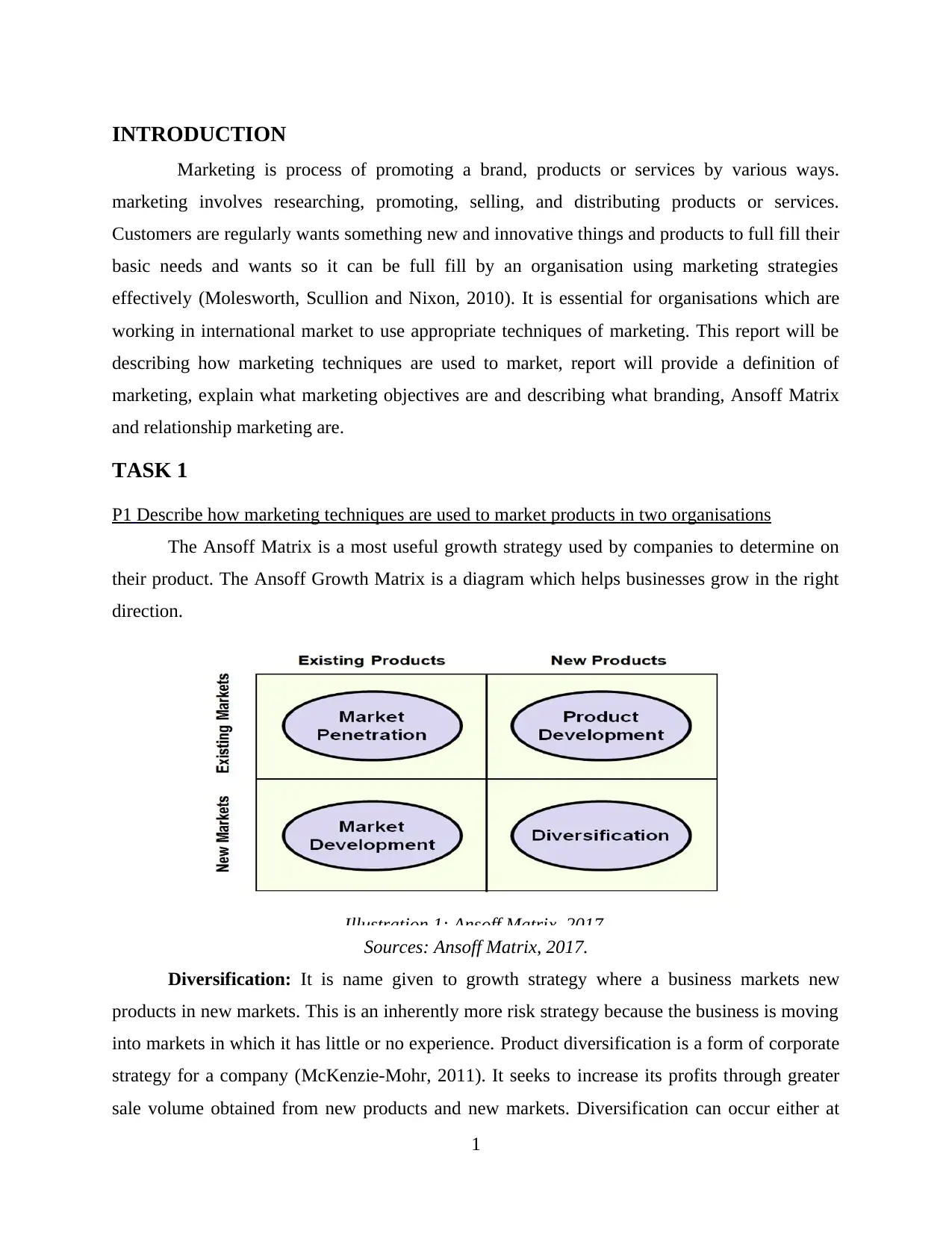
INTRODUCTION
Marketing is process of promoting a brand, products or services by various ways.
marketing involves researching, promoting, selling, and distributing products or services.
Customers are regularly wants something new and innovative things and products to full fill their
basic needs and wants so it can be full fill by an organisation using marketing strategies
effectively (Molesworth, Scullion and Nixon, 2010). It is essential for organisations which are
working in international market to use appropriate techniques of marketing. This report will be
describing how marketing techniques are used to market, report will provide a definition of
marketing, explain what marketing objectives are and describing what branding, Ansoff Matrix
and relationship marketing are.
TASK 1
P1 Describe how marketing techniques are used to market products in two organisations
The Ansoff Matrix is a most useful growth strategy used by companies to determine on
their product. The Ansoff Growth Matrix is a diagram which helps businesses grow in the right
direction.
Sources: Ansoff Matrix, 2017.
Diversification: It is name given to growth strategy where a business markets new
products in new markets. This is an inherently more risk strategy because the business is moving
into markets in which it has little or no experience. Product diversification is a form of corporate
strategy for a company (McKenzie-Mohr, 2011). It seeks to increase its profits through greater
sale volume obtained from new products and new markets. Diversification can occur either at
1
Illustration 1: Ansoff Matrix, 2017.
Marketing is process of promoting a brand, products or services by various ways.
marketing involves researching, promoting, selling, and distributing products or services.
Customers are regularly wants something new and innovative things and products to full fill their
basic needs and wants so it can be full fill by an organisation using marketing strategies
effectively (Molesworth, Scullion and Nixon, 2010). It is essential for organisations which are
working in international market to use appropriate techniques of marketing. This report will be
describing how marketing techniques are used to market, report will provide a definition of
marketing, explain what marketing objectives are and describing what branding, Ansoff Matrix
and relationship marketing are.
TASK 1
P1 Describe how marketing techniques are used to market products in two organisations
The Ansoff Matrix is a most useful growth strategy used by companies to determine on
their product. The Ansoff Growth Matrix is a diagram which helps businesses grow in the right
direction.
Sources: Ansoff Matrix, 2017.
Diversification: It is name given to growth strategy where a business markets new
products in new markets. This is an inherently more risk strategy because the business is moving
into markets in which it has little or no experience. Product diversification is a form of corporate
strategy for a company (McKenzie-Mohr, 2011). It seeks to increase its profits through greater
sale volume obtained from new products and new markets. Diversification can occur either at
1
Illustration 1: Ansoff Matrix, 2017.
⊘ This is a preview!⊘
Do you want full access?
Subscribe today to unlock all pages.

Trusted by 1+ million students worldwide
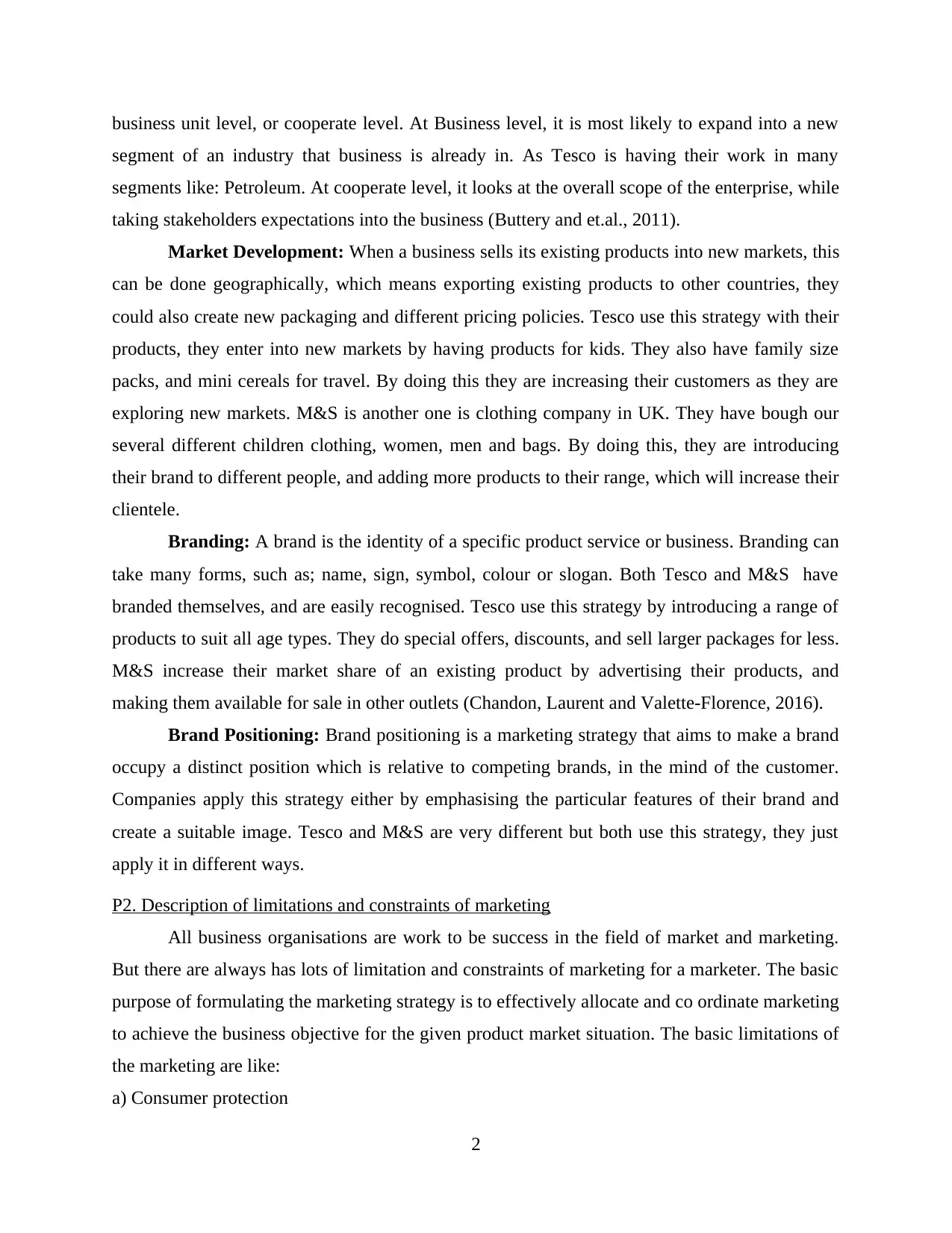
business unit level, or cooperate level. At Business level, it is most likely to expand into a new
segment of an industry that business is already in. As Tesco is having their work in many
segments like: Petroleum. At cooperate level, it looks at the overall scope of the enterprise, while
taking stakeholders expectations into the business (Buttery and et.al., 2011).
Market Development: When a business sells its existing products into new markets, this
can be done geographically, which means exporting existing products to other countries, they
could also create new packaging and different pricing policies. Tesco use this strategy with their
products, they enter into new markets by having products for kids. They also have family size
packs, and mini cereals for travel. By doing this they are increasing their customers as they are
exploring new markets. M&S is another one is clothing company in UK. They have bough our
several different children clothing, women, men and bags. By doing this, they are introducing
their brand to different people, and adding more products to their range, which will increase their
clientele.
Branding: A brand is the identity of a specific product service or business. Branding can
take many forms, such as; name, sign, symbol, colour or slogan. Both Tesco and M&S have
branded themselves, and are easily recognised. Tesco use this strategy by introducing a range of
products to suit all age types. They do special offers, discounts, and sell larger packages for less.
M&S increase their market share of an existing product by advertising their products, and
making them available for sale in other outlets (Chandon, Laurent and Valette-Florence, 2016).
Brand Positioning: Brand positioning is a marketing strategy that aims to make a brand
occupy a distinct position which is relative to competing brands, in the mind of the customer.
Companies apply this strategy either by emphasising the particular features of their brand and
create a suitable image. Tesco and M&S are very different but both use this strategy, they just
apply it in different ways.
P2. Description of limitations and constraints of marketing
All business organisations are work to be success in the field of market and marketing.
But there are always has lots of limitation and constraints of marketing for a marketer. The basic
purpose of formulating the marketing strategy is to effectively allocate and co ordinate marketing
to achieve the business objective for the given product market situation. The basic limitations of
the marketing are like:
a) Consumer protection
2
segment of an industry that business is already in. As Tesco is having their work in many
segments like: Petroleum. At cooperate level, it looks at the overall scope of the enterprise, while
taking stakeholders expectations into the business (Buttery and et.al., 2011).
Market Development: When a business sells its existing products into new markets, this
can be done geographically, which means exporting existing products to other countries, they
could also create new packaging and different pricing policies. Tesco use this strategy with their
products, they enter into new markets by having products for kids. They also have family size
packs, and mini cereals for travel. By doing this they are increasing their customers as they are
exploring new markets. M&S is another one is clothing company in UK. They have bough our
several different children clothing, women, men and bags. By doing this, they are introducing
their brand to different people, and adding more products to their range, which will increase their
clientele.
Branding: A brand is the identity of a specific product service or business. Branding can
take many forms, such as; name, sign, symbol, colour or slogan. Both Tesco and M&S have
branded themselves, and are easily recognised. Tesco use this strategy by introducing a range of
products to suit all age types. They do special offers, discounts, and sell larger packages for less.
M&S increase their market share of an existing product by advertising their products, and
making them available for sale in other outlets (Chandon, Laurent and Valette-Florence, 2016).
Brand Positioning: Brand positioning is a marketing strategy that aims to make a brand
occupy a distinct position which is relative to competing brands, in the mind of the customer.
Companies apply this strategy either by emphasising the particular features of their brand and
create a suitable image. Tesco and M&S are very different but both use this strategy, they just
apply it in different ways.
P2. Description of limitations and constraints of marketing
All business organisations are work to be success in the field of market and marketing.
But there are always has lots of limitation and constraints of marketing for a marketer. The basic
purpose of formulating the marketing strategy is to effectively allocate and co ordinate marketing
to achieve the business objective for the given product market situation. The basic limitations of
the marketing are like:
a) Consumer protection
2
Paraphrase This Document
Need a fresh take? Get an instant paraphrase of this document with our AI Paraphraser

b) Promoting healthy competition
c) Environmental protection
Some major legislation of marketing areas is described:
In the UK consumer market, Marks & Spencer has faces different limitation and constraints. The
limitations are generally coming from the different act, provisions and the organisational
policies. UK government, European Union and the other international voluntary services has
made the provisions and codes for operates the business with maintain the conditions. Marks
&Spencer may faces limitation from the government, customers, EU, competitors and other
stakeholders.
Goods act, 1979: Goods or products are the main limitation as per the act of goods act 1979. The
act was mentioned that are conducted by the parliament of the UK which regulates the
commercial law in respect of goods that are sold and bought. The act is made by the set of
formation of the contract. The contract of sale, capacity to buy and sell, and ascertainment of
price, agreement to sell at valuation, condition and warranty are the core element of this act.
The consumer protection from Unfair Trading Regulations act, 2008: Consumer protection
act is the regulation that is a general duty not to trade unfairly therefore being honest and fair to
all customers. Consumer protection act is mostly practices on price claims, product
information,competitors, and sales methods and as well as sales services. The legislation is
providing the rights of consumer to search, choose and selection of products (Laroche, 2010).
Use of voluntary codes and conditions: The voluntary code of advertising practice in
businesses the one of limitation of the marketing process of activities for business. The major six
issues are mentioned in this section.
1) Decency
2) Truthfulness
3) Health claims
4) Safety
TASK 2
P3. Organisation uses marketing research to contribute to development
Primary research will benefit the company because it’s the collection of first hand
information. For example, M&S may choose to hand out questionnaires in order to find out what
3
c) Environmental protection
Some major legislation of marketing areas is described:
In the UK consumer market, Marks & Spencer has faces different limitation and constraints. The
limitations are generally coming from the different act, provisions and the organisational
policies. UK government, European Union and the other international voluntary services has
made the provisions and codes for operates the business with maintain the conditions. Marks
&Spencer may faces limitation from the government, customers, EU, competitors and other
stakeholders.
Goods act, 1979: Goods or products are the main limitation as per the act of goods act 1979. The
act was mentioned that are conducted by the parliament of the UK which regulates the
commercial law in respect of goods that are sold and bought. The act is made by the set of
formation of the contract. The contract of sale, capacity to buy and sell, and ascertainment of
price, agreement to sell at valuation, condition and warranty are the core element of this act.
The consumer protection from Unfair Trading Regulations act, 2008: Consumer protection
act is the regulation that is a general duty not to trade unfairly therefore being honest and fair to
all customers. Consumer protection act is mostly practices on price claims, product
information,competitors, and sales methods and as well as sales services. The legislation is
providing the rights of consumer to search, choose and selection of products (Laroche, 2010).
Use of voluntary codes and conditions: The voluntary code of advertising practice in
businesses the one of limitation of the marketing process of activities for business. The major six
issues are mentioned in this section.
1) Decency
2) Truthfulness
3) Health claims
4) Safety
TASK 2
P3. Organisation uses marketing research to contribute to development
Primary research will benefit the company because it’s the collection of first hand
information. For example, M&S may choose to hand out questionnaires in order to find out what
3
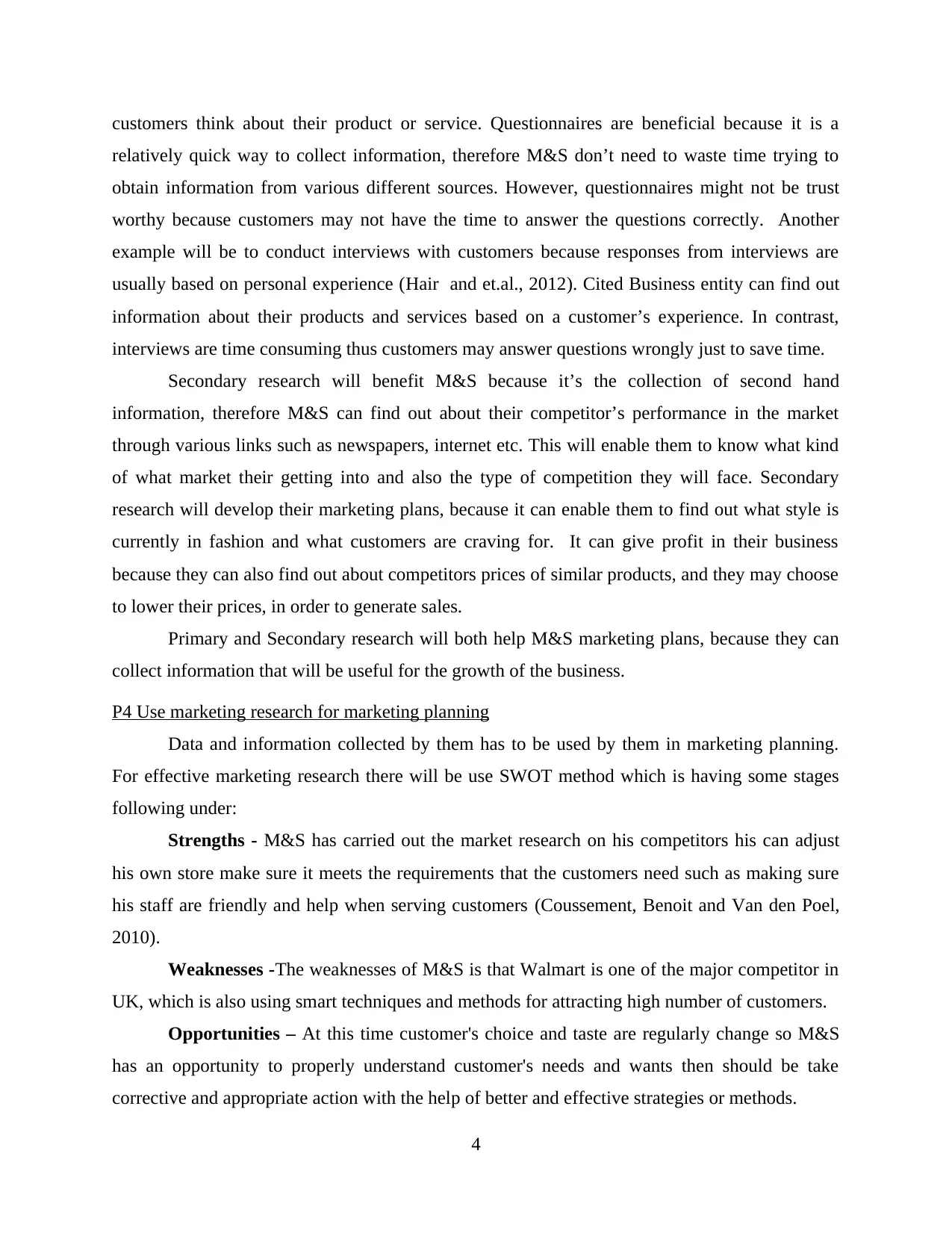
customers think about their product or service. Questionnaires are beneficial because it is a
relatively quick way to collect information, therefore M&S don’t need to waste time trying to
obtain information from various different sources. However, questionnaires might not be trust
worthy because customers may not have the time to answer the questions correctly. Another
example will be to conduct interviews with customers because responses from interviews are
usually based on personal experience (Hair and et.al., 2012). Cited Business entity can find out
information about their products and services based on a customer’s experience. In contrast,
interviews are time consuming thus customers may answer questions wrongly just to save time.
Secondary research will benefit M&S because it’s the collection of second hand
information, therefore M&S can find out about their competitor’s performance in the market
through various links such as newspapers, internet etc. This will enable them to know what kind
of what market their getting into and also the type of competition they will face. Secondary
research will develop their marketing plans, because it can enable them to find out what style is
currently in fashion and what customers are craving for. It can give profit in their business
because they can also find out about competitors prices of similar products, and they may choose
to lower their prices, in order to generate sales.
Primary and Secondary research will both help M&S marketing plans, because they can
collect information that will be useful for the growth of the business.
P4 Use marketing research for marketing planning
Data and information collected by them has to be used by them in marketing planning.
For effective marketing research there will be use SWOT method which is having some stages
following under:
Strengths - M&S has carried out the market research on his competitors his can adjust
his own store make sure it meets the requirements that the customers need such as making sure
his staff are friendly and help when serving customers (Coussement, Benoit and Van den Poel,
2010).
Weaknesses -The weaknesses of M&S is that Walmart is one of the major competitor in
UK, which is also using smart techniques and methods for attracting high number of customers.
Opportunities – At this time customer's choice and taste are regularly change so M&S
has an opportunity to properly understand customer's needs and wants then should be take
corrective and appropriate action with the help of better and effective strategies or methods.
4
relatively quick way to collect information, therefore M&S don’t need to waste time trying to
obtain information from various different sources. However, questionnaires might not be trust
worthy because customers may not have the time to answer the questions correctly. Another
example will be to conduct interviews with customers because responses from interviews are
usually based on personal experience (Hair and et.al., 2012). Cited Business entity can find out
information about their products and services based on a customer’s experience. In contrast,
interviews are time consuming thus customers may answer questions wrongly just to save time.
Secondary research will benefit M&S because it’s the collection of second hand
information, therefore M&S can find out about their competitor’s performance in the market
through various links such as newspapers, internet etc. This will enable them to know what kind
of what market their getting into and also the type of competition they will face. Secondary
research will develop their marketing plans, because it can enable them to find out what style is
currently in fashion and what customers are craving for. It can give profit in their business
because they can also find out about competitors prices of similar products, and they may choose
to lower their prices, in order to generate sales.
Primary and Secondary research will both help M&S marketing plans, because they can
collect information that will be useful for the growth of the business.
P4 Use marketing research for marketing planning
Data and information collected by them has to be used by them in marketing planning.
For effective marketing research there will be use SWOT method which is having some stages
following under:
Strengths - M&S has carried out the market research on his competitors his can adjust
his own store make sure it meets the requirements that the customers need such as making sure
his staff are friendly and help when serving customers (Coussement, Benoit and Van den Poel,
2010).
Weaknesses -The weaknesses of M&S is that Walmart is one of the major competitor in
UK, which is also using smart techniques and methods for attracting high number of customers.
Opportunities – At this time customer's choice and taste are regularly change so M&S
has an opportunity to properly understand customer's needs and wants then should be take
corrective and appropriate action with the help of better and effective strategies or methods.
4
⊘ This is a preview!⊘
Do you want full access?
Subscribe today to unlock all pages.

Trusted by 1+ million students worldwide
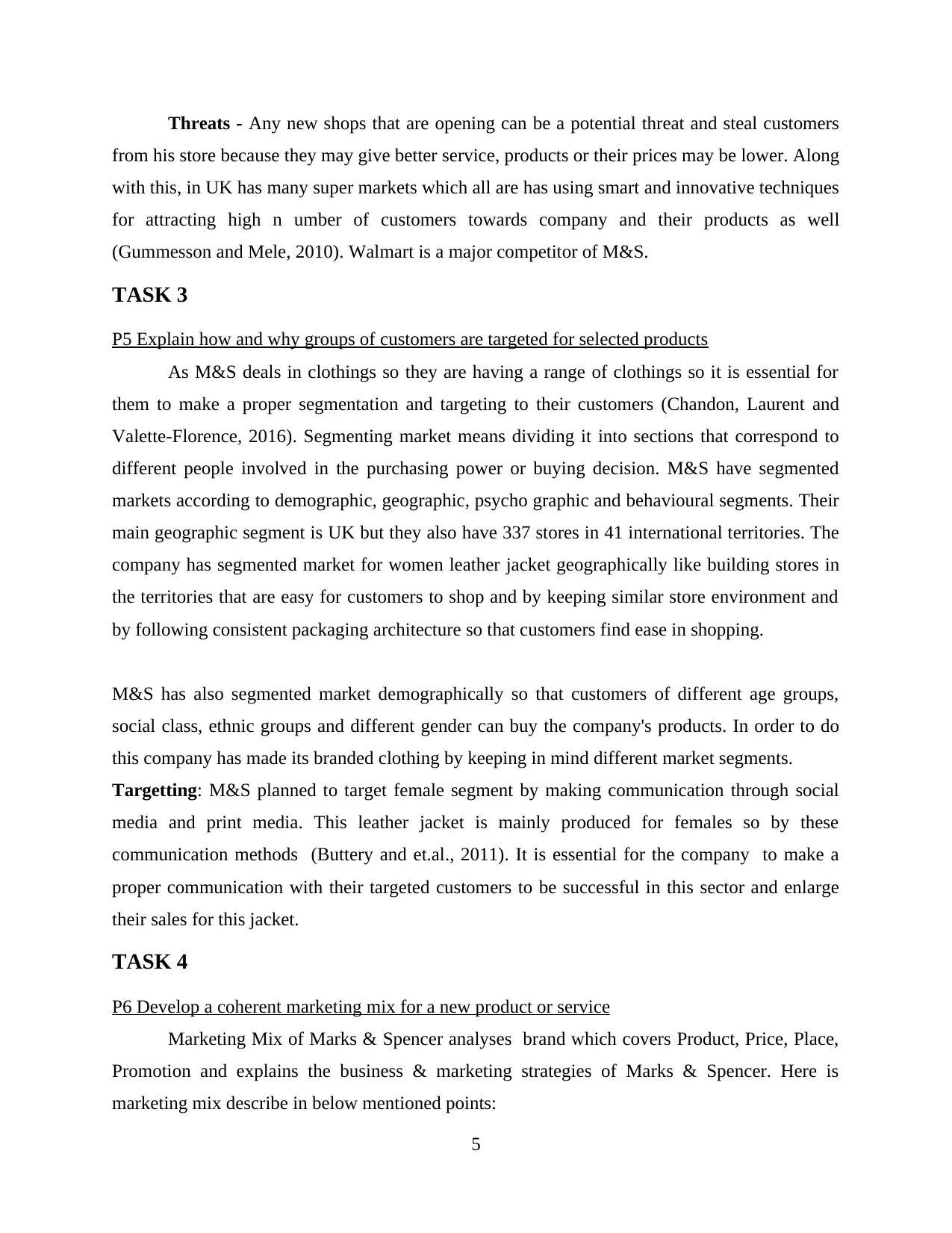
Threats - Any new shops that are opening can be a potential threat and steal customers
from his store because they may give better service, products or their prices may be lower. Along
with this, in UK has many super markets which all are has using smart and innovative techniques
for attracting high n umber of customers towards company and their products as well
(Gummesson and Mele, 2010). Walmart is a major competitor of M&S.
TASK 3
P5 Explain how and why groups of customers are targeted for selected products
As M&S deals in clothings so they are having a range of clothings so it is essential for
them to make a proper segmentation and targeting to their customers (Chandon, Laurent and
Valette-Florence, 2016). Segmenting market means dividing it into sections that correspond to
different people involved in the purchasing power or buying decision. M&S have segmented
markets according to demographic, geographic, psycho graphic and behavioural segments. Their
main geographic segment is UK but they also have 337 stores in 41 international territories. The
company has segmented market for women leather jacket geographically like building stores in
the territories that are easy for customers to shop and by keeping similar store environment and
by following consistent packaging architecture so that customers find ease in shopping.
M&S has also segmented market demographically so that customers of different age groups,
social class, ethnic groups and different gender can buy the company's products. In order to do
this company has made its branded clothing by keeping in mind different market segments.
Targetting: M&S planned to target female segment by making communication through social
media and print media. This leather jacket is mainly produced for females so by these
communication methods (Buttery and et.al., 2011). It is essential for the company to make a
proper communication with their targeted customers to be successful in this sector and enlarge
their sales for this jacket.
TASK 4
P6 Develop a coherent marketing mix for a new product or service
Marketing Mix of Marks & Spencer analyses brand which covers Product, Price, Place,
Promotion and explains the business & marketing strategies of Marks & Spencer. Here is
marketing mix describe in below mentioned points:
5
from his store because they may give better service, products or their prices may be lower. Along
with this, in UK has many super markets which all are has using smart and innovative techniques
for attracting high n umber of customers towards company and their products as well
(Gummesson and Mele, 2010). Walmart is a major competitor of M&S.
TASK 3
P5 Explain how and why groups of customers are targeted for selected products
As M&S deals in clothings so they are having a range of clothings so it is essential for
them to make a proper segmentation and targeting to their customers (Chandon, Laurent and
Valette-Florence, 2016). Segmenting market means dividing it into sections that correspond to
different people involved in the purchasing power or buying decision. M&S have segmented
markets according to demographic, geographic, psycho graphic and behavioural segments. Their
main geographic segment is UK but they also have 337 stores in 41 international territories. The
company has segmented market for women leather jacket geographically like building stores in
the territories that are easy for customers to shop and by keeping similar store environment and
by following consistent packaging architecture so that customers find ease in shopping.
M&S has also segmented market demographically so that customers of different age groups,
social class, ethnic groups and different gender can buy the company's products. In order to do
this company has made its branded clothing by keeping in mind different market segments.
Targetting: M&S planned to target female segment by making communication through social
media and print media. This leather jacket is mainly produced for females so by these
communication methods (Buttery and et.al., 2011). It is essential for the company to make a
proper communication with their targeted customers to be successful in this sector and enlarge
their sales for this jacket.
TASK 4
P6 Develop a coherent marketing mix for a new product or service
Marketing Mix of Marks & Spencer analyses brand which covers Product, Price, Place,
Promotion and explains the business & marketing strategies of Marks & Spencer. Here is
marketing mix describe in below mentioned points:
5
Paraphrase This Document
Need a fresh take? Get an instant paraphrase of this document with our AI Paraphraser
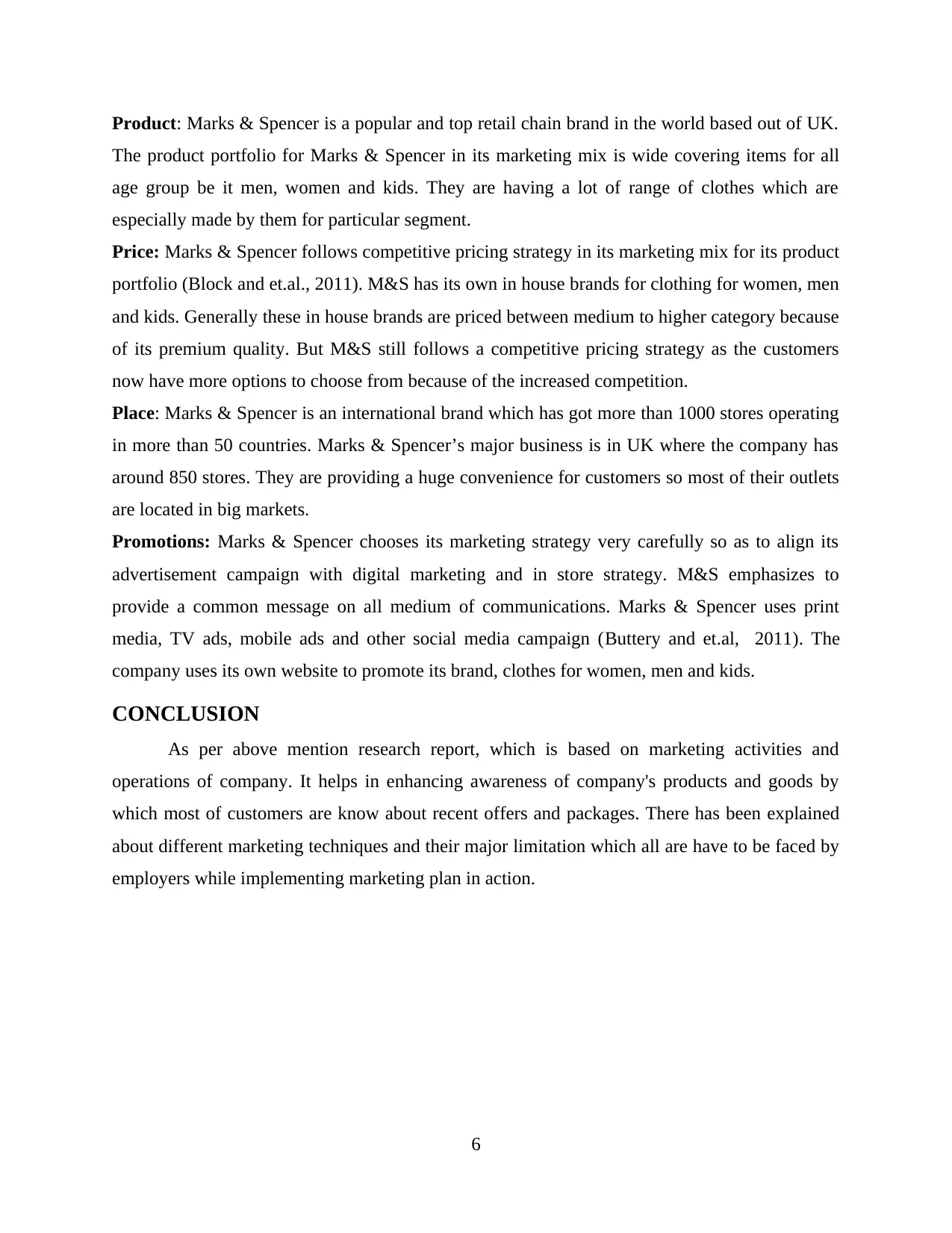
Product: Marks & Spencer is a popular and top retail chain brand in the world based out of UK.
The product portfolio for Marks & Spencer in its marketing mix is wide covering items for all
age group be it men, women and kids. They are having a lot of range of clothes which are
especially made by them for particular segment.
Price: Marks & Spencer follows competitive pricing strategy in its marketing mix for its product
portfolio (Block and et.al., 2011). M&S has its own in house brands for clothing for women, men
and kids. Generally these in house brands are priced between medium to higher category because
of its premium quality. But M&S still follows a competitive pricing strategy as the customers
now have more options to choose from because of the increased competition.
Place: Marks & Spencer is an international brand which has got more than 1000 stores operating
in more than 50 countries. Marks & Spencer’s major business is in UK where the company has
around 850 stores. They are providing a huge convenience for customers so most of their outlets
are located in big markets.
Promotions: Marks & Spencer chooses its marketing strategy very carefully so as to align its
advertisement campaign with digital marketing and in store strategy. M&S emphasizes to
provide a common message on all medium of communications. Marks & Spencer uses print
media, TV ads, mobile ads and other social media campaign (Buttery and et.al, 2011). The
company uses its own website to promote its brand, clothes for women, men and kids.
CONCLUSION
As per above mention research report, which is based on marketing activities and
operations of company. It helps in enhancing awareness of company's products and goods by
which most of customers are know about recent offers and packages. There has been explained
about different marketing techniques and their major limitation which all are have to be faced by
employers while implementing marketing plan in action.
6
The product portfolio for Marks & Spencer in its marketing mix is wide covering items for all
age group be it men, women and kids. They are having a lot of range of clothes which are
especially made by them for particular segment.
Price: Marks & Spencer follows competitive pricing strategy in its marketing mix for its product
portfolio (Block and et.al., 2011). M&S has its own in house brands for clothing for women, men
and kids. Generally these in house brands are priced between medium to higher category because
of its premium quality. But M&S still follows a competitive pricing strategy as the customers
now have more options to choose from because of the increased competition.
Place: Marks & Spencer is an international brand which has got more than 1000 stores operating
in more than 50 countries. Marks & Spencer’s major business is in UK where the company has
around 850 stores. They are providing a huge convenience for customers so most of their outlets
are located in big markets.
Promotions: Marks & Spencer chooses its marketing strategy very carefully so as to align its
advertisement campaign with digital marketing and in store strategy. M&S emphasizes to
provide a common message on all medium of communications. Marks & Spencer uses print
media, TV ads, mobile ads and other social media campaign (Buttery and et.al, 2011). The
company uses its own website to promote its brand, clothes for women, men and kids.
CONCLUSION
As per above mention research report, which is based on marketing activities and
operations of company. It helps in enhancing awareness of company's products and goods by
which most of customers are know about recent offers and packages. There has been explained
about different marketing techniques and their major limitation which all are have to be faced by
employers while implementing marketing plan in action.
6
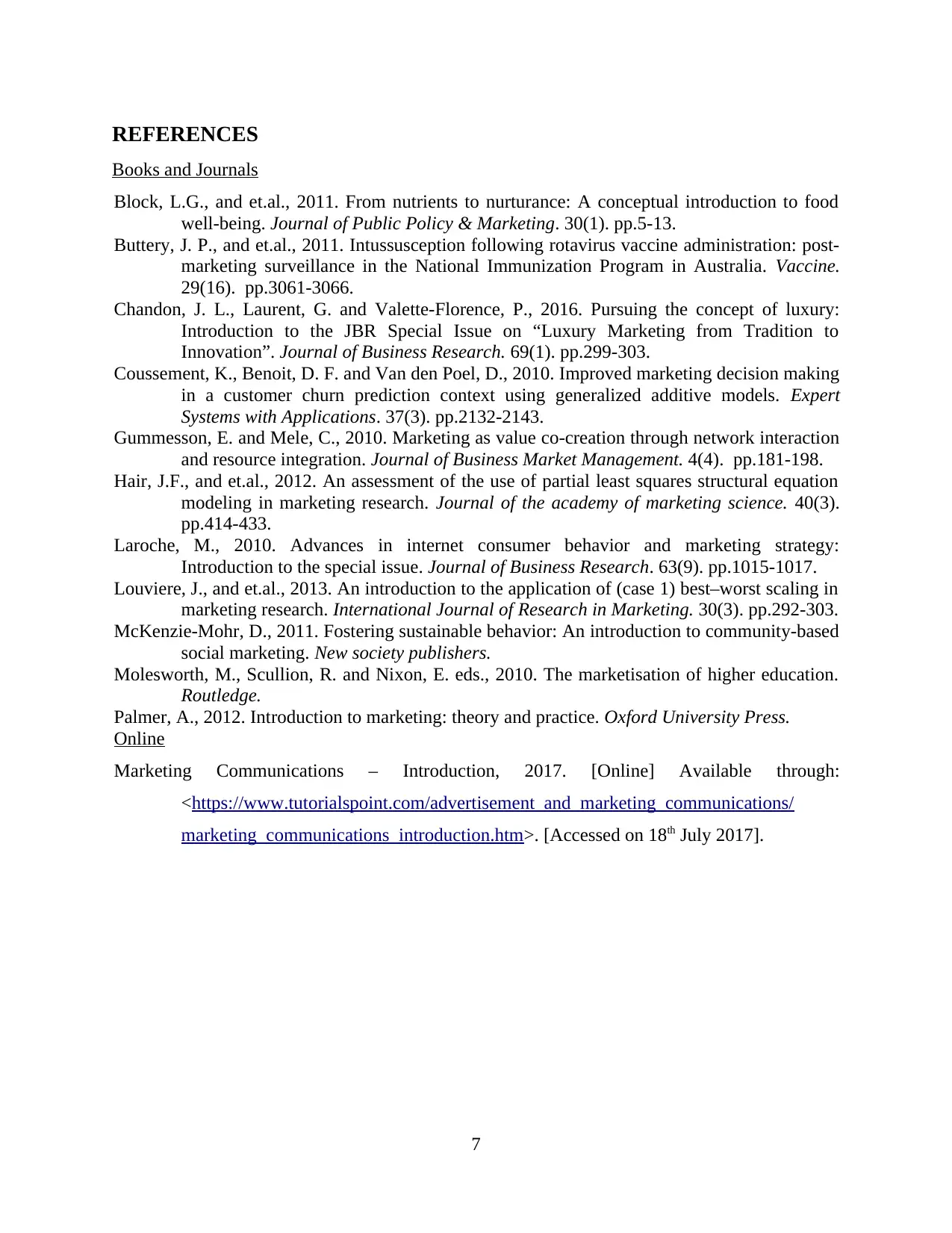
REFERENCES
Books and Journals
Block, L.G., and et.al., 2011. From nutrients to nurturance: A conceptual introduction to food
well-being. Journal of Public Policy & Marketing. 30(1). pp.5-13.
Buttery, J. P., and et.al., 2011. Intussusception following rotavirus vaccine administration: post-
marketing surveillance in the National Immunization Program in Australia. Vaccine.
29(16). pp.3061-3066.
Chandon, J. L., Laurent, G. and Valette-Florence, P., 2016. Pursuing the concept of luxury:
Introduction to the JBR Special Issue on “Luxury Marketing from Tradition to
Innovation”. Journal of Business Research. 69(1). pp.299-303.
Coussement, K., Benoit, D. F. and Van den Poel, D., 2010. Improved marketing decision making
in a customer churn prediction context using generalized additive models. Expert
Systems with Applications. 37(3). pp.2132-2143.
Gummesson, E. and Mele, C., 2010. Marketing as value co-creation through network interaction
and resource integration. Journal of Business Market Management. 4(4). pp.181-198.
Hair, J.F., and et.al., 2012. An assessment of the use of partial least squares structural equation
modeling in marketing research. Journal of the academy of marketing science. 40(3).
pp.414-433.
Laroche, M., 2010. Advances in internet consumer behavior and marketing strategy:
Introduction to the special issue. Journal of Business Research. 63(9). pp.1015-1017.
Louviere, J., and et.al., 2013. An introduction to the application of (case 1) best–worst scaling in
marketing research. International Journal of Research in Marketing. 30(3). pp.292-303.
McKenzie-Mohr, D., 2011. Fostering sustainable behavior: An introduction to community-based
social marketing. New society publishers.
Molesworth, M., Scullion, R. and Nixon, E. eds., 2010. The marketisation of higher education.
Routledge.
Palmer, A., 2012. Introduction to marketing: theory and practice. Oxford University Press.
Online
Marketing Communications – Introduction, 2017. [Online] Available through:
<https://www.tutorialspoint.com/advertisement_and_marketing_communications/
marketing_communications_introduction.htm>. [Accessed on 18th July 2017].
7
Books and Journals
Block, L.G., and et.al., 2011. From nutrients to nurturance: A conceptual introduction to food
well-being. Journal of Public Policy & Marketing. 30(1). pp.5-13.
Buttery, J. P., and et.al., 2011. Intussusception following rotavirus vaccine administration: post-
marketing surveillance in the National Immunization Program in Australia. Vaccine.
29(16). pp.3061-3066.
Chandon, J. L., Laurent, G. and Valette-Florence, P., 2016. Pursuing the concept of luxury:
Introduction to the JBR Special Issue on “Luxury Marketing from Tradition to
Innovation”. Journal of Business Research. 69(1). pp.299-303.
Coussement, K., Benoit, D. F. and Van den Poel, D., 2010. Improved marketing decision making
in a customer churn prediction context using generalized additive models. Expert
Systems with Applications. 37(3). pp.2132-2143.
Gummesson, E. and Mele, C., 2010. Marketing as value co-creation through network interaction
and resource integration. Journal of Business Market Management. 4(4). pp.181-198.
Hair, J.F., and et.al., 2012. An assessment of the use of partial least squares structural equation
modeling in marketing research. Journal of the academy of marketing science. 40(3).
pp.414-433.
Laroche, M., 2010. Advances in internet consumer behavior and marketing strategy:
Introduction to the special issue. Journal of Business Research. 63(9). pp.1015-1017.
Louviere, J., and et.al., 2013. An introduction to the application of (case 1) best–worst scaling in
marketing research. International Journal of Research in Marketing. 30(3). pp.292-303.
McKenzie-Mohr, D., 2011. Fostering sustainable behavior: An introduction to community-based
social marketing. New society publishers.
Molesworth, M., Scullion, R. and Nixon, E. eds., 2010. The marketisation of higher education.
Routledge.
Palmer, A., 2012. Introduction to marketing: theory and practice. Oxford University Press.
Online
Marketing Communications – Introduction, 2017. [Online] Available through:
<https://www.tutorialspoint.com/advertisement_and_marketing_communications/
marketing_communications_introduction.htm>. [Accessed on 18th July 2017].
7
⊘ This is a preview!⊘
Do you want full access?
Subscribe today to unlock all pages.

Trusted by 1+ million students worldwide
1 out of 9
Related Documents
Your All-in-One AI-Powered Toolkit for Academic Success.
+13062052269
info@desklib.com
Available 24*7 on WhatsApp / Email
![[object Object]](/_next/static/media/star-bottom.7253800d.svg)
Unlock your academic potential
Copyright © 2020–2025 A2Z Services. All Rights Reserved. Developed and managed by ZUCOL.





